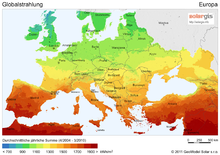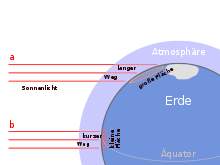Insolation
Insolation (from Latin insolare "to expose to the sun", "to warm"), also solar radiation or solar radiation, is the incidence of solar radiation on a surface or body. In the earth sciences, insolation is the flux of solar radiation incident on a portion of the Earth's surface, the ocean surface, or the atmosphere; in ecology, it is the flux of solar radiation incident on an ecosystem; in medicine, it is a synonym for sunstroke. Insolation as a physical quantity is a radiant flux density with the unit watts per square meter (W/m2). The radiant flux density per wavelength is the irradiation, in W/(m2-μm).
Insolation above the Earth's atmosphere is described by the solar constant. Part of the solar radiation is reflected in the Earth's atmosphere, part is absorbed and scattered (→ extinction). If we consider the insolation at the Earth's surface, the indirect, diffuse celestial radiation is added to the shadow-casting direct radiation of the Sun; the sum of direct and diffuse radiation is called global radiation. It is measured with the pyranometer. The direct radiation at a location can be measured with pyrheliometers or actinometers. The insolation at a location on Earth depends on the angle of incidence of the sun and thus on the latitude, exposure of the area, time of day and season (→ Lambert's law). Cloudiness of the atmosphere can reduce the insolation of the Earth's surface.
Almost all energy reaches the earth via solar radiation, which is effective on its surface and in the atmosphere in the climate system. It also acts on the soil and rocks, causing noticeable fluctuations in soil temperature with variable irradiation, which contribute to mechanical weathering (→ insolation weathering). These phenomena include core cracking and scaling. Furthermore, insolation causes meteorological phenomena such as the steady onshore wind on elongated coasts: During the day, the land warms up faster than the sea due to insolation, which tends to cause air above the land to rise and flow in from the sea.
The Earth's orbit around the Sun, as well as the precession and inclination of the Earth's axis, fluctuate cyclically over a period of tens of thousands to hundreds of thousands of years. This causes the angle of incidence and distribution of solar radiation to change in the northern and southern hemispheres. These insolation fluctuations, in combination with feedback effects, partly explain natural climate changes on Earth, including the alternation between cold and interglacial periods of the Cenozoic Ice Age (→ Milanković cycles). The radiation emitted by the Sun is also subject to changes and fluctuations on different time scales, which are reflected in changes in the solar constants. According to the standard model of the Sun, its radiant output gradually increases, by about one-third over the course of about 4.5 billion years of Earth's history. In addition, a series of activity cycles are thought to occur, with a period of thousands to hundreds of years. The Schwabe cycle, which lasts about 11 years and is accompanied by a slight change in the solar constant of about 1 W/m2, has been proven with certainty.
The energy of the sun, e.g. via photosynthesis, is of crucial importance for living organisms. In medicine, insolation is considered on the human organism and its duration - solar irradiation. Excessive exposure of the head to the sun can cause sunstroke, also called insolatio, insolation or insolation encephalitis. In dermatology, the sun exposure of the human skin is considered as it occurs during sunbathing.
In astronomy, insolation can also be observed in exoplanets with close orbits, see Hot Jupiter.

Global radiation in EuropeSolarGIS © 2011 GeoModel Solar s.r.o.

Dependence of the insolation (here: the direct radiation at the earth's surface) on the angle of incidence
Questions and Answers
Q: What is insolation?
A: Insolation is the solar radiation that reaches the earth's surface.
Q: How is insolation measured?
A: Insolation is measured by the amount of solar energy received per square centimetre per minute.
Q: What is solar energy?
A: Solar energy is the heat derived from the sun's radiation.
Q: What affects the amount of insolation received on earth?
A: Season, latitude, transparency of the atmosphere, and aspect or ground slope affect the amount of insolation received on earth.
Q: How does insolation affect temperature?
A: The more the insolation, the higher the temperature.
Q: When is the strongest insolation received in a day?
A: The strongest insolation is received at noon.
Q: Can solar energy be called insolation when it is received by the earth?
A: Yes, solar energy received by the earth is called insolation.
Search within the encyclopedia